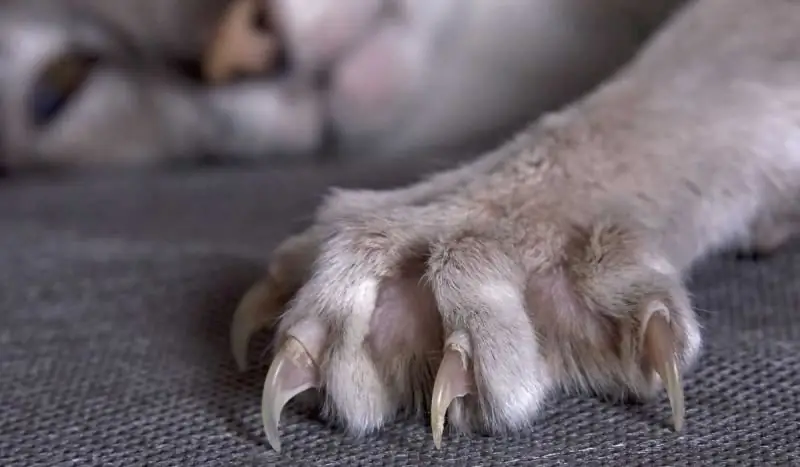
Table of contents:
- Chipping cats: a necessity or a whim?
- Chips for animals: what they are and what they are for
- How cats are chipped
- Common misconceptions about the procedure
- Veterinarians' opinion on the impact on cat health
- Identification, tracking and data storage during chipping
- The cost of the procedure
- Precautions
- Cat owners reviews
- Author Bailey Albertson [email protected].
- Public 2023-12-17 12:53.
- Last modified 2025-06-01 07:32.
Chipping cats: a necessity or a whim?

Thoughts about the safety of the pet often come to the owner of the cat, and they are justified - being in the street conditions is dangerous for the apartment animal. Chipping is one of the methods of protecting an animal, which greatly increases the possibility of returning it home after loss.
Content
-
1 Chips for animals: what they are and what they are for
-
1.1 Advantages and Disadvantages of Chipping
1.1.1 Video: Chipping Pets
-
- 2 How is chipping of cats carried out
- 3 Common misconceptions about the procedure
- 4 The opinion of veterinarians on the impact on the health of the cat
-
5 Identification, tracking and data storage during chipping
5.1 Video: live cat chipping
- 6 Cost of the procedure
- 7 Precautions
- 8 Cat owner reviews
Chips for animals: what they are and what they are for
The chip is needed for instant electronic identification of an animal, which is most relevant when it is lost or stolen. According to statistics, the frequency of returning a chipped animal to the owner is 90%.
The chip is a 13 × 2 mm biocompatible glass capsule, which contains:
- chip;
- receiver - to receive the scanner signal;
- transmitter - for transmitting stored data;
- memory block - code is stored here;
-
antenna for signal amplification.

Electronic chip Chips for cats the size of a grain of rice
The latest chip models can contain thermometry sensors, and the scanner receives information about the chip code and the body temperature of the animal.
The chip is inserted under the skin, its service life is unlimited. It does not need energy sources such as batteries.
The chip is safe for the cat:
- biocompatible glass capsule does not cause inflammation and allergic reaction;
- is a passive device that is activated only in the magnetic field of the scanner, does not have its own radiation;
- does not bother the pet.
Chipping advantages and disadvantages
Chipping has both undeniable advantages and disadvantages.
Chipping advantages:
- the chip is required for exporting an animal to the EU countries, for example, to visit exhibitions or when moving;
- instant identification of an animal when it is lost;
- confirmation of ownership of the animal in disputable cases, for example, in court;
- facilitation of bureaucratic procedures related to the registration and identification of pets at veterinary stations, veterinary hospitals, customs and other organizations;
- excluding the possibility of replacing a cat with similar animals, for example, at exhibitions, mating, selling high-bred kittens;
- low cost of the procedure;
- universality - the chip can be read in any country where the procedure is carried out in accordance with accepted international standards;
- reliability of the method - the chip functions for the whole life of the cat, it cannot be removed or lost.
Disadvantages of chipping:
- the chipping procedure in the Russian Federation is voluntary, therefore it is carried out only in large cities, in small settlements there are no chips or scanners;
- chipping is not yet widespread, so it is possible that the found animal will be looking for a phone on a collar, an address tag, a breeding mark, but not a chip;
- sale by unscrupulous clinics of non-functioning or obsolete chips (you need to ensure that the veterinarian checks the chip with a scanner in your presence before installing it);
- the impossibility of determining the code, and therefore the owner of the animal, by an ordinary person who has found a pet (a scanner is required).
In general, the disadvantages of chipping are due to its still small distribution.
Video: chipping pets
How cats are chipped
Chipping is carried out in veterinary clinics exclusively by doctors licensed for this type of activity. The introduction of the chip, in its essence, is a subcutaneous injection and gives the pet comparable sensations, therefore, anesthesia is not accompanied.

The capsule is inserted into the hollow part of the needle of a special syringe and injected under the skin of the animal
Each chip is supplied with a sterile disposable injector (syringe). After checking the chip, the veterinarian treats the skin with an antiseptic and, using an injector, injects it under the animal's skin. Potential injection sites:
- the area of the withers is the most common place;
- area of the left scapula;
- the inner surface of the paws (in hairless cat breeds).
After inserting the chip, the veterinarian checks it again with a scanner. A month later, a second scan is performed for control purposes. During this time, it is already fixed under the skin with connective tissue.

Chipping in a cat is comparable to a subcutaneous injection
Common misconceptions about the procedure
Some biases keep the owner from chipping their cat:
- Chipping domestic cats is useless, especially when they don't have free range. According to statistics, cats run away at least as often as dogs, and it is important to return the fugitive couch potato as early as possible, since domestic cats are poorly adapted to outdoor existence, and this poses a threat to their lives. Therefore, chipping is necessary for both purebred pets and their outbred brethren, who have much less opportunity to get lost and get attention and care.
- Chipping is painful and distressing to your pet. The pain of chipping is comparable to the pain of a subcutaneous injection, and the installed chip does not give the pet any sensations.
- The chips are displaced and become useless. The chip can indeed move 2-3 cm from the implantation site under the animal's skin, but this does not affect the reading of the code from it.
- The chip allows you to track the movement of the animal in real time. Chipping, unlike a GPS tracker, does not provide such an opportunity, so the owner of a lost pet should wait for the chip data to be read and the cat returned.
-
The chip data can be read by scanning the smartphone camera. To read the data, you need a special scanner. You can use a smartphone to scan an NFC tag, which looks like a plastic medallion located on an animal's collar. The chip is located under the skin.

Scanner for reading information Information from the chip can only be read by a special scanner
- The chip will be discharged and stop working. The chip does not need batteries, its service life is unlimited.
Veterinarians' opinion on the impact on cat health
Veterinarians believe that chipping is safe for animal health, so the procedure can be performed on very young kittens at the age of 5-6 weeks. It can be combined with the first vaccination.
Chipping is not carried out in animals:
- patients with infectious diseases;
- with pustular and fungal processes on the skin, especially near the area of the chip introduction - to prevent its infection and the spread of skin infection;
- with the general unsatisfactory condition of the animal.
Identification, tracking and data storage during chipping
Each chip has a unique code that is entered at the factory and is not subject to further changes.
The code consists of fifteen digits:
- the first three are the country code - for the Russian Federation it is 643;
- the next 4 digits are the manufacturer's code, of which the first is 0, the separator between the codes; this code can reliably identify the manufacturer of the chip, since it is registered in the ICAR system (The International Committee for Animal Recording); this can help avoid cheating with the manufacturer, for example, passing off a Chinese chip as a German or Russian one;
- the last 8 are the individual number of the animal.
Chip production is carried out in accordance with international standards ISO 11784 and ISO 11785.
The data of the chip and the animal that it has chipped is entered into the Animal-ID or Animalface database. These are Russian databases that are part of the international pet search engine Petmaxx.com.
The owner is given a plastic card, the information on which duplicates the data entered into the database and is presented in two languages:
- surname, name, patronymic of the owner of the cat;
- home address;
- contact number;
- the number of the chip entered into the cat;
- cat's name;
- pet breed, date of birth;
- color;
- date and place of implantation.
The card is certified by the stamp of the clinic and the signature of the veterinarian. In the veterinary passport of the cat, a mark is made about the introduction of the chip.
It is better to check the information about entering the data of the chip and the cat into the database personally. It is not difficult: you need to enter the chip data on the website of a Russian or international database.
The reading distance depends on the antenna and is approximately 10 cm. When reading the code, the scanner emits a signal, and 15 digits are displayed on its display.
The chip is activated 5-10 days after implantation.
Video: live cat chipping
The cost of the procedure
The cost of the chipping procedure depends on the region, the pricing policy of the clinic and on average ranges from 1000 to 2000 rubles. You should not agree to carry out chipping for a lower price, as this can result in:
- the introduction of a chip from an unreliable manufacturer, which will not be read, and can also cause inflammatory or allergic reactions in the surrounding tissues;
- inadequate level of service provision, for example, data will not be entered into the electronic database or will be entered incorrectly.
The chip should only be installed in reputable veterinary clinics.
Precautions
After the introduction of the microchip, it is prohibited for 3 days:
- moisten the place where the chip is inserted with water;
- bathe the cat;
- comb the hair over the chip insertion site.
During the first 5-7 days, the chip engrafts, and the cat may try to comb the implantation site with its paw - in this case, it is worth putting on a protective collar.
Cat owners reviews
Chipping is a safe procedure that helps identify the cat as well as establish its owner. It is carried out by implanting a microchip under the animal's skin, while the chip code, as well as the data of the animal and its owner, are entered into international databases. The code is read using a special scanner. Chipping pets is a worldwide practice, and it is impossible to import cats without a chip into a number of countries.
Recommended:
Mating Cats And Cats: How Mating Takes Place, At What Age Should The First Mating Of Pets And Other Advice To Owners

The timing of puberty in cats and cats. First mating rules. Preparation for mating. Choosing a partner. Mating process of cats. Signs of pregnancy. Reviews
To What Age Do Cats And Cats Grow, Which Affects The Growth Rate Of Animals, Reviews Of Veterinarians And Pet Owners

Growth stages of cats. What influences this process, what prevents it. How cats of different breeds grow. How to create conditions for the growth of a kitten. Owner reviews
Castration Of A Cat: When (at What Age) Can A Pet Be Castrated, The Pros And Cons Of The Procedure, What To Do Before And After The Operation

Castration of a cat: arguments for and against, features and rules of the procedure, caring for a pet in the first days after surgery and in the subsequent period
Classes Of Food For Adult Cats And Kittens: Description Of Species And Categories, Classification By Consistency, Dry And Wet, Age And More

What are the ready-made cat food. How do they differ from each other. What foods should not be given to cats
Removal Of Claws In Cats: Advantages And Disadvantages Of The "soft Feet" Operation, Technique Of The Procedure, Consequences, Reviews Of The Owners

The purpose of the claw. Why do cats scratch furniture? Description of the operation: types, advantages and disadvantages, contraindications, consequences. Alternatives to surgery
